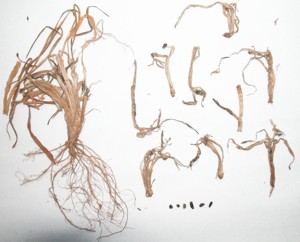Diseases
Sclerotinia borealis Bubak et Vleugel - Sclerotinia Snow Mold.
Systematic position.
Class Ascomycetes, subclass Euascomycetidae, order Helotiales, family Sclerotiniacea, genus Sclerotinia. Synonyms: S. graminearum Elenev, Whetzelinia borealis (Bubak et Vleugel) Khokhr.Biological group.
Hemibiotrophic wheat pathogen.Morphology and biology.
Disease appears in early spring when snow thaws. Gray cottony thread-like fungal sporulation may often be seen on the affected leaves and wheat stems. In spring a large quantity of sclerotia (1.5-6 x 1-3 mm in size) and grayish fungal spawn are formed. In summer the sclerotia mature on soil surface or on dead leaves of damaged plants. The sclerotia germinate in autumn, producing apothecia (ascomata) (2.5 to 6 mm in diameter). Asci are cylindrical (175-300 x 10-14 .), ascospores are inequilateral (16-23 x 17-10 .). Ascospores are primary inoculum for infection of winter wheat seedlings.Distribution.
The Sclerotinia Snow Mold is widely distributed on winter cereals in the north-east of the European part of Russian Federation, mainly in Kirov and Svedlov Regions, Udmurtia, Bashkortostan, Mari El, Tatarstan, Mordovia and Chuvashia. In some years the disease is observed to a lesser degree in other neighboring and distant regions, such as Tula, Moscow, Yaroslavl., Ivanovo, Vladimir, Smolensk, Volgograd, Leningrad, Arkhangelsk, Chelyabinsk Regions and Belorussia, Krasnoyarsk and Primorskii Territories (Tupenevich, 1939, 1940; Klaptsova, 1947; Shalavin, 1960; Chumakov, 1961; Sanin, 2000).Ecology.
A prolonged period under diffuse light is required for maturating and germination of sclerotia in spring. If immature sclerotia are ploughed in soil at 3 to 6 cm in depth, they perish after a time. In autumn maturing sclerotia need light, high air and soil humidity, and low temperature (2 to 12.C) for germination.Economic significance.
Sclerotinia Snow Mold affects wheat, rye, and wild cereals. Infected leaf blades and lower parts of stems macerate, become grayish-brown, and wither which results in crop-thinning in fields. Sclerotinia Mold damage may occur on weak wheat plants when snow falls on unfrozen ground, and soil is wet. Damage also occurrs in years with low spring temperatures and with winter thaws. The disease is likely to occur in low wet areas. Protection measures include removing the sources of infection by weed control and autumn plowing, the use of crop rotation, optimal period for sowing, fertilization, resistant cultivars.Reference citations.
Chumakov A.E. 1961. Mold of winter cereals. In: Distribution of insects and diseases of agricultural crops in RSFSR in 1960 and prediction of their appearance in 1961. Leningrad: VASKNIL, VIZR. 73-75 p. (In Russian)Klaptsova N.K. 1947. Sclerotinia on winter cereals in Chelyabinsk Region and protection measures. Chelyabinsk: ChelyabGIZ. 22 p. (In Russian)
Sanin S.A. 2000. To increase the level of phytosanitary safety of the country. Zashchita rastenii i karantin, 12: 3-7. (In Russian)
Shalavin A.I. 1960. Preservation of winter cereals against sclerotinia. Zashchita rastenii ot vreditelei I boleznei, 9: 23-24. (In Russian)
Tupenevich S.M. 1939. Sclerotinia on cereals in Kirov Region and Udmurtskaya ASSR. Reports of Kirov Science-research Institute of regional ethnography. Kirov: Kirov Publishing House. N. 16: 32. (In Russian)
Tupenevich S.M. 1940. The causes of outbreaks of severe development of Sclerotinia and Fusarium nivale on winter sowing and withering of agricultural crops. Summury of the scientific research work of the Institute of plant protection for the year 1939. Leningrad: Sel.khozgiz. 67-71 p. (In Russian)
Tupenevich S.M. 1965. Mold of winter crops. Reports of All Russian Science-Research Institute of Plant Protection: Distribution of insects and diseases of agricultural crops in RSFSR in 1964. Leningrad: Kolos. V. 25: 118-120. (In Russian)
© Gultyaeva E.I.


